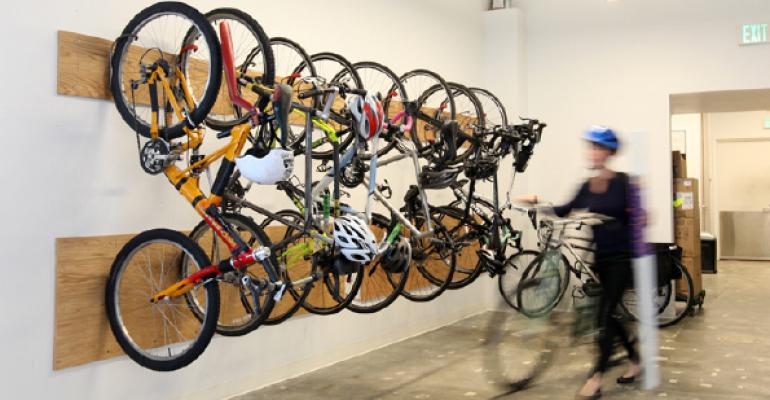An unusual landlord/tenant pilot partnership is underway between The Swig Co., a Bay Area commercial real estate investor and operator, and Project Frog, a maker of technologically-advanced component buildings. The two firms have partnered to turn what set out to be a straightforward retrofit office project into a showcase for technologically advanced design and sustainable building in downtown San Francisco.
A “living laboratory” for sustainable building" has been created out of Project Frog’s new headquarters at 501 Second Street, which is owned and operated by The Swig Co. Project Frog occupies 13,000 sq. ft. on the ground floor.
The building, which is located in the South of Market neighborhood, is filled with tech companies and startup ventures and currently has no vacancies.
Project Frog—led by CEO Ann Hand, who was named one of Fortune's 10 Most Powerful Women Entrepreneurs in 2013—designs and manufactures component buildings that can be assembled easily onsite, mainly for schools, health care facilities and retail. Project Frog’s mission is to overcome the inefficiencies of traditional construction by providing a fast and cost-effective way to create greener and smarter spaces.
In addition to the launch of the "living laboratory," The Swig Co. is also celebrating 501 Second Street's recent LEED Platinum designation, which is shared by only 1 percent of San Francisco buildings.
The idea for partnership grew out of a discussion between Hand and Deborah Boyer, senior vice president-asset management for The Swig Co., and Ann Hand, CEO of Project Frog, a company that produces ready-to-assemble “smart” buildings that was looking for new headquarters space. A “tinker lab” workshop was built in Project Frog’s 13,000-square-foot office space where visitors can watch its staff design, prototype or fabricate building components using state-of-the-art software or the company’s new 3D printer.
Though Swig is studying the cost of its new product investment in the Project Frog space, examining its benefits in terms of potential energy savings, operational efficiencies, enhanced tenant experience and employee wellness), Boyer told The Registry, a Bay Area real estate publication, that, in some cases, it makes sense to upgrade an existing building’s infrastructure in conjunction with implementation of new technology,although every situation must be reviewed separately. For example, she pointed out, the Comfy system, was selected because of its compatibility with the existing VAV system and controls. “There is no ‘one-size-fits-all’ with existing buildings,” she said.
Highlights of The Swig Co. and Project Frog's “living laboratory” include:
· A complete daylight autonomy system by Lutron has automated shades that are integrated with digitally addressable dimming LED drivers that maximize interior daylight while minimizing the need for supplemental electric light, increasing space flexibility, occupant comfort and productivity;
· The Comfy system, one of the new technologies that Swig is implementing throughout its portfolio, allows occupants to interact with the heating and cooling system through a cloud based web interface. Users become the sensors and drive the HVAC system to deliver significantly better comfort and user experience. This system is part of a whole host of new technologies and approaches that The Swig Company is deploying as a market leader in supplying superior office space to its tenants.
· Lantana Luminaires, an energy-efficient LED lighting system designed by Project Frog, lights spaces by balancing color temperature and optimal light distribution in a sleek plug-and-play fixture.
· The “Tinker Lab,” a fun, creative workshop within the Project Frog office, showcases staff members designing, prototyping and fabricating building components using state-of-art software and a new 3D printer.

